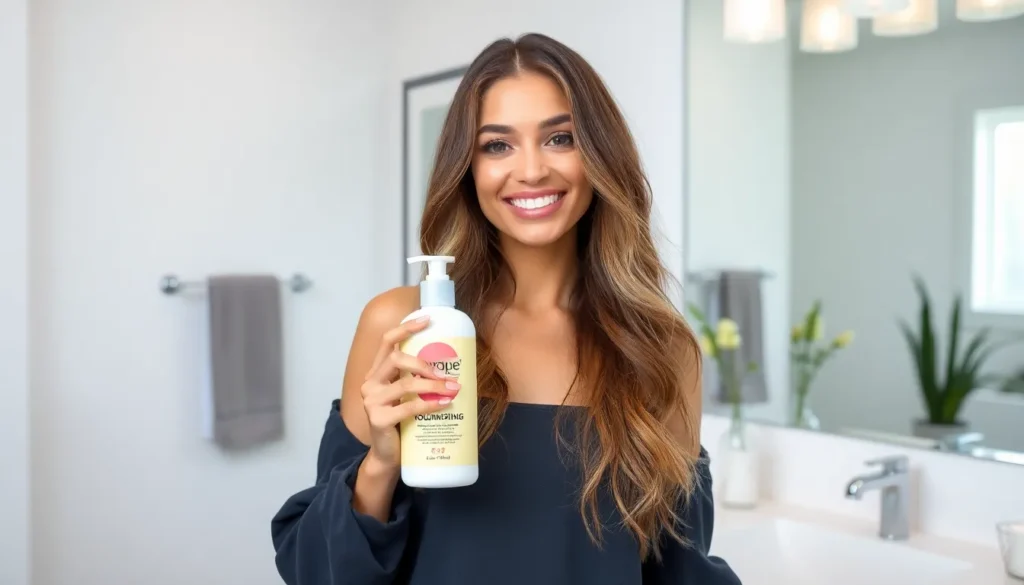Dealing with thin hair can feel like an uphill battle that leaves us frustrated and self-conscious about our appearance. We’ve all been there – standing in front of the mirror wishing our hair had more volume body and thickness. The good news? Thin hair doesn’t have to define our style or limit our confidence.
Understanding the root causes of thin hair is the first step toward transforming our locks from lackluster to luxurious. Whether we’re dealing with genetics hormonal changes or environmental factors there are proven strategies that can help us achieve fuller-looking hair. From choosing the right products to mastering styling techniques we can create the illusion of thicker hair while promoting healthy growth.
We’re here to guide you through everything you need to know about managing thin hair effectively. Our comprehensive approach covers styling secrets product recommendations and lifestyle changes that’ll help you embrace your hair’s natural beauty while maximizing its potential.
Understanding Thin Hair vs Fine Hair: Key Differences You Need to Know
Many people use these terms interchangeably, but thin hair and fine hair represent completely different characteristics that require distinct approaches to styling and care.
Density vs Diameter: The Science Behind Hair Texture
Hair density measures how many individual strands grow from each square inch of your scalp. We typically see around 2,200 hair follicles per square inch on a healthy scalp, though this number varies significantly between individuals. Those with thin hair have fewer follicles overall, creating visible gaps between strands and potentially exposing more scalp area.
Hair diameter determines the actual thickness of each individual strand. Fine hair measures less than 0.04 inches in diameter, while coarse hair exceeds 0.07 inches. Medium hair falls somewhere between these measurements. You can have dense fine hair that appears full and voluminous, or sparse coarse hair that looks thin even though each strand being thick.
Combination patterns create four distinct hair types we encounter:
- Dense fine hair: Many thin strands creating apparent fullness
- Dense coarse hair: Many thick strands resulting in maximum volume
- Sparse fine hair: Few thin strands appearing most fragile
- Sparse coarse hair: Few thick strands with visible spacing
Common Misconceptions About Thin Hair Types
Myth: Fine hair always looks flat and lifeless. Reality shows us that fine hair can achieve incredible volume with proper techniques and products. Lightweight mousses and root-lifting sprays work exceptionally well on fine strands because they don’t weigh down the delicate structure.
Myth: Cutting hair shorter always makes thin hair appear fuller. Strategic layering and length choices depend entirely on your face shape and hair growth patterns. Some people achieve better fullness with longer styles that add weight to pull hair down, while others benefit from shorter cuts that create lift at the roots.
Myth: Thin hair can’t handle color treatments or styling. Professional colorists regularly work with thin hair using gentler formulations and application techniques. Heat styling remains perfectly safe when you use proper heat protectants and lower temperature settings.
Myth: You’re stuck with thin hair forever. Scalp health improvements, hormonal balance restoration, and proper nutrition can significantly impact hair density over time. We’ve seen remarkable transformations when people address underlying causes like thyroid issues, nutrient deficiencies, or chronic stress.
Identifying the Root Causes of Thinning Hair

Understanding why your hair becomes thinner helps us address the issue more effectively. Let’s examine the main factors that contribute to hair density loss.
Genetic Factors and Hereditary Hair Loss
Androgenetic alopecia affects 95% of men and 40% of women over age 50, making it the most common cause of thinning hair. We inherit this condition through genes from both parents, not just our maternal grandfather as commonly believed.
Male pattern baldness typically begins with receding temples and crown thinning, while women experience diffuse thinning across the top of their head. The hormone dihydrotestosterone (DHT) shrinks hair follicles over time, causing strands to become progressively thinner and shorter.
Family history serves as the strongest predictor of hereditary hair loss. Parents, siblings, aunts, uncles, and grandparents with thinning hair increase your likelihood of developing the condition. Starting earlier in life often indicates a more aggressive progression pattern.
Hormonal Changes and Medical Conditions
Thyroid disorders disrupt normal hair growth cycles in approximately 1 in 8 women. Hypothyroidism slows hair production while hyperthyroidism accelerates hair loss. Both conditions require medical treatment to restore healthy hair growth.
Pregnancy and menopause create important hormonal shifts that temporarily or permanently alter hair density. Post-pregnancy hair loss peaks 3-4 months after delivery when estrogen levels drop dramatically. Menopausal women lose up to 40% of their hair volume due to declining estrogen production.
PCOS affects 1 in 10 women of reproductive age and often causes male pattern hair loss due to elevated androgen levels. Insulin resistance accompanying PCOS can worsen hair thinning. Managing blood sugar levels through diet and medication helps preserve hair density.
Autoimmune conditions like alopecia areata create patchy hair loss when the immune system attacks healthy follicles. Stress-related conditions such as telogen effluvium cause widespread thinning 2-3 months after a triggering event.
Environmental and Lifestyle Triggers
Chronic stress elevates cortisol levels which disrupts the hair growth cycle and pushes follicles into a resting phase. Work pressure, relationship issues, financial concerns, and major life changes commonly trigger stress-related hair loss.
Nutritional deficiencies weaken hair structure and slow growth rates. Iron deficiency affects 25% of premenopausal women and directly correlates with thinning hair. Protein, vitamin D, B vitamins, and zinc deficiencies also contribute to reduced hair density.
| Essential Hair Nutrients | Daily Requirement | Hair Loss Risk |
|---|---|---|
| Iron | 18mg (women), 8mg (men) | High with deficiency |
| Protein | 0.8g per kg body weight | Moderate with inadequate intake |
| Vitamin D | 600-800 IU | Emerging research shows connection |
| Biotin | 30mcg | Low unless severely deficient |
Chemical processing damages hair shafts and weakens follicles through repeated bleaching, perming, or relaxing treatments. Heat styling above 300°F causes protein damage that makes hair appear thinner and more fragile.
Tight hairstyles create traction alopecia when constant pulling stresses hair follicles. Braids, ponytails, buns, and extensions worn regularly can cause permanent follicle damage along the hairline and crown area.
Choosing the Right Hair Care Products for Thin Hair
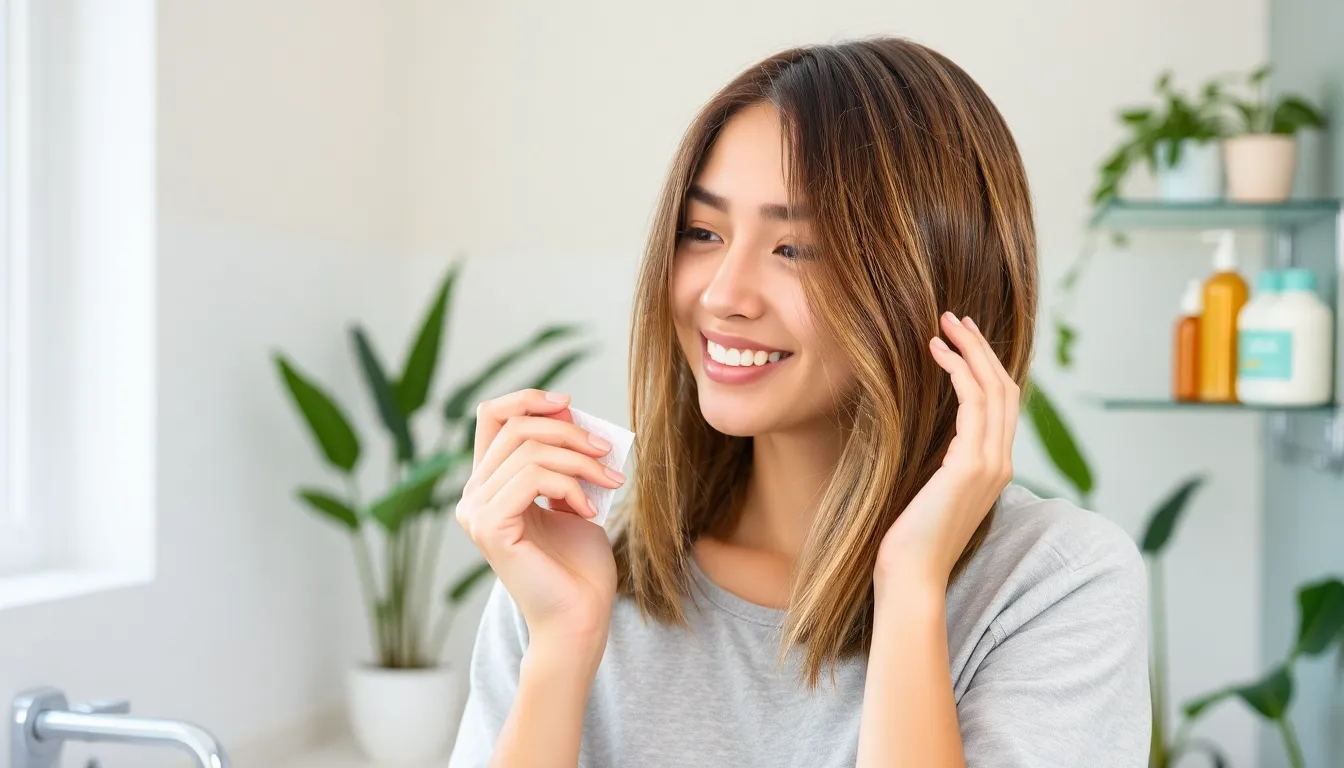
Product selection becomes crucial when you’re working with thin hair because the wrong formulas can weigh down strands and make density issues more apparent.
Volumizing Shampoos and Lightweight Conditioners
Volumizing shampoos work by gently cleansing hair while removing excess oils and product buildup that can flatten thin strands. Look for formulas containing rice protein, biotin, or keratin amino acids that strengthen hair fibers without adding weight. Brands like Pureology Pure Volume and Living Proof Full Shampoo use these ingredients to create lift at the roots while maintaining scalp health.
Lightweight conditioners provide essential moisture without the heavy silicones found in traditional formulas. Apply conditioner only to mid-lengths and ends of your hair, avoiding the root area where natural oils already exist. Conditioners with hydrolyzed wheat protein or panthenol offer detangling benefits while preserving natural volume.
Frequency matters when washing thin hair because overwashing strips natural oils, while underwashing allows buildup to accumulate. Most thin hair types benefit from washing every other day or three times per week, depending on your scalp’s oil production and styling product usage.
Hair Masks and Treatments That Won’t Weigh You Down
Protein treatments strengthen thin hair strands by filling microscopic gaps in the hair cuticle. Use treatments containing hydrolyzed silk or quinoa protein once weekly to rebuild hair structure without creating heaviness. Olaplex No. 3 Hair Perfector and K18 Leave-in Molecular Repair Mask deliver professional-grade results at home.
Scalp treatments promote healthy hair growth by improving blood circulation and removing follicle-blocking debris. Massaging rosemary oil or peppermint oil into your scalp twice weekly can stimulate growth and increase hair density over time. These treatments work best when applied to clean, damp hair before styling.
Application technique determines treatment effectiveness for thin hair types. Use treatments sparingly, focusing on damaged areas rather than coating entire strands. Rinse thoroughly to prevent residue buildup that can make hair appear limp and lifeless.
Styling Products That Add Body Without Buildup
Root lifting sprays create instant volume when applied to damp hair before blow-drying. Products containing polymers like VP/VA copolymer grip hair strands and maintain lift throughout the day. Spray directly onto roots in small sections, then use a round brush while blow-drying for maximum effectiveness.
Texturizing powders absorb excess oils while creating grip and separation between hair strands. Sprinkle powder onto roots and massage gently, then brush through to distribute evenly. These products work exceptionally well for refreshing second-day styles and adding body to fine hair textures.
Mousse formulas provide long-lasting hold without the stiffness of traditional gels or hairsprays. Choose alcohol-free mousses that won’t dry out thin strands, and scrunch product through damp hair from roots to tips. Modern formulations like Bumble and Bumble Thickening Full Form Mousse offer flexible hold with natural movement.
Mastering Hair Washing Techniques for Maximum Volume

Getting your washing routine right can make or break your thin hair’s volume potential. We’ll show you exactly how to cleanse and condition for maximum lift.
Optimal Washing Frequency for Thin Hair
Washing every other day works best for most thin hair types. Daily washing strips natural oils that provide essential body and protection to delicate strands. But, waiting too long between washes allows oil buildup to weigh down already fragile hair.
People with oily scalps need daily cleansing to prevent flatness. Excess sebum production creates heavy roots that kill volume before it starts. Monitor how your hair looks and feels 24 hours after washing to determine your ideal schedule.
Dry shampoo extends time between washes while adding texture. Apply it to roots the night before washing for maximum oil absorption. This technique prevents product buildup while giving hair extra grip and lift.
Fine hair requires more frequent washing than coarse thin hair. The smaller diameter makes each strand more susceptible to oil transfer from the scalp. Adjust your routine based on how quickly your hair loses volume rather than following generic advice.
Proper Application Methods for Shampoo and Conditioner
Focus shampoo application exclusively on your scalp and roots. Massage gently with fingertips rather than nails to avoid damaging fragile follicles. The cleansing action naturally travels down the hair shaft as you rinse without weighing down the lengths.
Dilute shampoo with water before applying for gentler cleansing. Mix a quarter size amount with equal parts water in your palm. This prevents harsh concentrated product from stripping essential moisture while still providing effective cleaning.
Apply conditioner only from mid-length to ends of hair. Keep it at least two inches away from your scalp to prevent root heaviness. Press the product into hair rather than rubbing to minimize breakage and tangling.
Use a wide tooth comb to distribute conditioner evenly through wet hair. Start from the ends and work upward to prevent snapping delicate strands. This ensures every section receives moisture without creating uneven weight distribution.
Leave lightweight conditioners on for 30 seconds maximum. Thin hair absorbs moisture quickly and can become oversaturated with longer processing times. Heavy conditioning leads to limp lifeless results that defeat volume building efforts.
Water Temperature and Rinsing Best Practices
Lukewarm water opens cuticles for better product penetration without damage. Hot water strips natural oils and causes swelling that makes thin hair appear even finer. Cold water seals cuticles but prevents thorough cleansing of product buildup.
Begin rinsing with lukewarm water then finish with cool water. The temperature transition removes all product residue while sealing the hair cuticle for maximum shine and smoothness. This two step process creates optimal conditions for volume styling.
Rinse for twice as long as you think necessary. Product residue weighs down thin hair more dramatically than thick hair types. Spend at least 60 seconds rinsing shampoo and 90 seconds removing all traces of conditioner from your strands.
Tilt your head in different directions while rinsing. Change angles to ensure water reaches every section of your scalp and hair. Leftover product in hard to reach areas creates uneven texture and kills volume in exact zones.
Press water from hair instead of wringing to prevent breakage. Squeeze gently from roots to ends using a downward motion. Twisting or rough handling damages the cuticle and creates frizz that makes thin hair look even more sparse.
Styling Methods That Create the Illusion of Thicker Hair
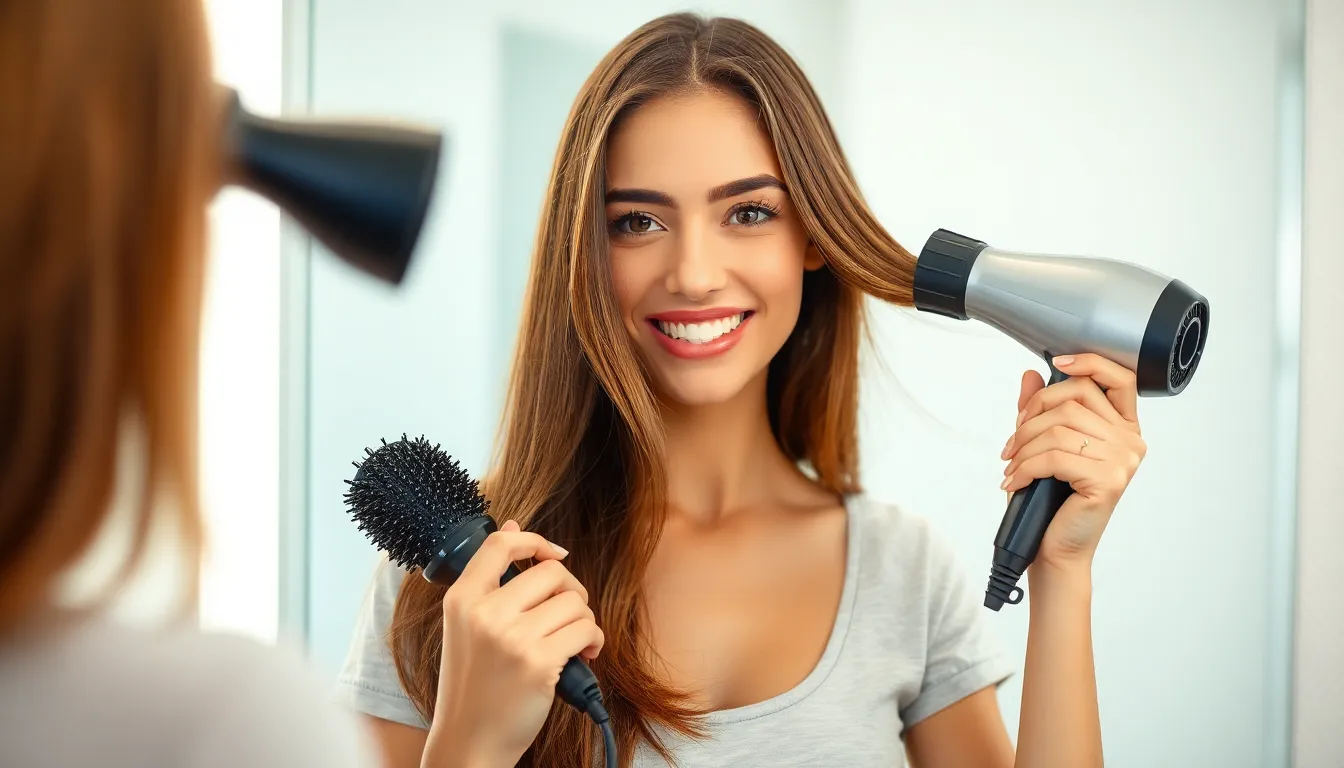
Mastering the right styling techniques transforms thin hair from flat to fabulous with strategic methods that boost volume and create density. These proven approaches work with your hair’s natural texture to maximize fullness without causing damage.
Blow Drying Techniques for Added Volume
Flip your head upside down and blow dry from roots to ends for instant lift that creates dramatic volume at the crown. Direct the airflow against your hair’s natural growth pattern using a round brush to lift each section away from the scalp.
Start with damp hair that’s been gently towel dried to remove excess moisture without roughing up the cuticles. Apply a volumizing mousse or root lifting spray before you begin the drying process for enhanced hold and body.
Use a medium-sized round brush to wrap small sections of hair and roll them away from your face while directing heat from above. Focus the blow dryer nozzle downward along the hair shaft to smooth the cuticle and add shine while maintaining volume.
Finish each section with a blast of cool air to set the lifted shape and lock in the volume you’ve created. This cool shot seals the hair cuticles and helps your style last longer throughout the day.
Heat Styling Tools and Temperature Guidelines
Set your styling tools between 250°F and 300°F to protect thin hair from heat damage while still achieving effective results. Higher temperatures can cause breakage and make already fine strands appear even thinner over time.
Choose ceramic or tourmaline tools that distribute heat evenly and reduce hot spots that can damage fragile hair. These materials also emit negative ions that smooth the hair cuticle and add natural shine without weighing down your strands.
Use a flat iron with narrow plates to create subtle waves and bends that add texture and movement to thin hair. Work with small sections and avoid clamping down too tightly to prevent crimping or breakage.
Apply a heat protectant spray before using any heated styling tools to create a barrier between your hair and potential damage. Look for lightweight formulas that won’t add buildup or weigh down your carefully crafted volume.
Texturizing and Teasing Methods
Backcomb sections at the crown using a fine-tooth comb to create controlled volume that appears natural and full. Start about two inches from your scalp and gently tease downward toward the roots for maximum lift.
Spray texturizing powder directly onto your roots and work it through with your fingers to add grip and substance to limp strands. These products absorb excess oil while creating the perfect foundation for volume that lasts all day.
Use the “pancaking” technique by gently pulling apart sections of styled hair to create width and fullness. This method works particularly well with braids and updos to make them appear thicker and more substantial.
Create piecey separation by running a small amount of lightweight styling paste through dry hair with your fingers. Focus on the mid-lengths and ends to add definition without flattening the roots where you need the most volume.
Selecting Flattering Haircuts for Thin Hair Types

Choosing the right haircut transforms thin hair from limp and lifeless to full and vibrant. Strategic cuts work with your hair’s natural properties to create visual density and movement.
Bob Cuts and Blunt Styles That Add Density
Blunt bob cuts create the strongest illusion of thickness for thin hair types. The sharp, even edges prevent tapered ends that reveal sparse areas and instead form a solid wall of hair that appears denser. We recommend keeping bob lengths between chin and shoulder level to maintain weight without overwhelming your frame.
Classic A-line bobs work exceptionally well because they’re slightly longer in front and shorter in back. This graduated shape adds dimension while the blunt edges preserve visual density. French bobs that hit just below the jawline maximize thickness appearance by concentrating hair volume in a compact area.
Asymmetrical bobs offer modern sophistication while boosting perceived fullness. The uneven lengths create visual interest and prevent thin hair from looking too uniform or flat. We suggest keeping the difference between sides subtle to maintain a polished appearance.
Maintenance becomes crucial with blunt cuts since even minimal growth creates tapered ends. Schedule trims every 6-8 weeks to preserve the crisp edges that make these styles effective for thin hair.
Layered Cuts That Enhance Movement
Strategic layering adds body and movement without sacrificing precious density in thin hair. Long layers starting below the collarbone create gentle movement while preserving most of your hair’s weight. This approach prevents the choppy, sparse look that can result from over-layering thin strands.
Face-framing layers around the front sections lift hair away from your scalp and create dimension. We recommend keeping these layers subtle and starting them at cheekbone level or lower to maintain fullness at the crown. Feathered ends in these front pieces add softness without appearing stringy.
Graduated layers work well for medium-length thin hair by creating a stacked effect. The shorter back sections provide lift and support for longer top layers, resulting in natural volume and movement. This technique works particularly well for those with fine, straight hair that tends to lie flat.
Avoid heavy layering throughout the entire head, as this removes too much density from already sparse hair. Instead, focus layers strategically where you want to create lift and movement while preserving weight in other areas.
Short Styles That Maximize Volume
Pixie cuts represent the ultimate volume-maximizing solution for severely thin hair. The short length eliminates weight that pulls hair down, allowing strands to stand up and create natural lift. Textured pixies with slightly longer pieces on top provide styling versatility while maintaining maximum body.
Cropped cuts with graduated sides and longer tops create incredible volume at the crown. The shorter sides prevent hair from looking flat against your head, while the longer top sections can be styled upward for dramatic height. We recommend keeping the top sections 2-3 inches long for optimal styling flexibility.
Shag cuts in short lengths combine the benefits of layering with the volume advantages of shorter hair. The choppy, textured layers create separation between strands, making each piece more visible and contributing to overall fullness. Modern shags avoid the extreme layering of vintage versions that could thin out sparse hair.
Buzz cuts with subtle length variations offer the most dramatic volume solution. Keeping the top slightly longer than the sides creates natural lift, while the overall short length eliminates any weight issues. This style works particularly well for those comfortable with very low-maintenance routines.
Professional Treatments and Solutions for Thin Hair
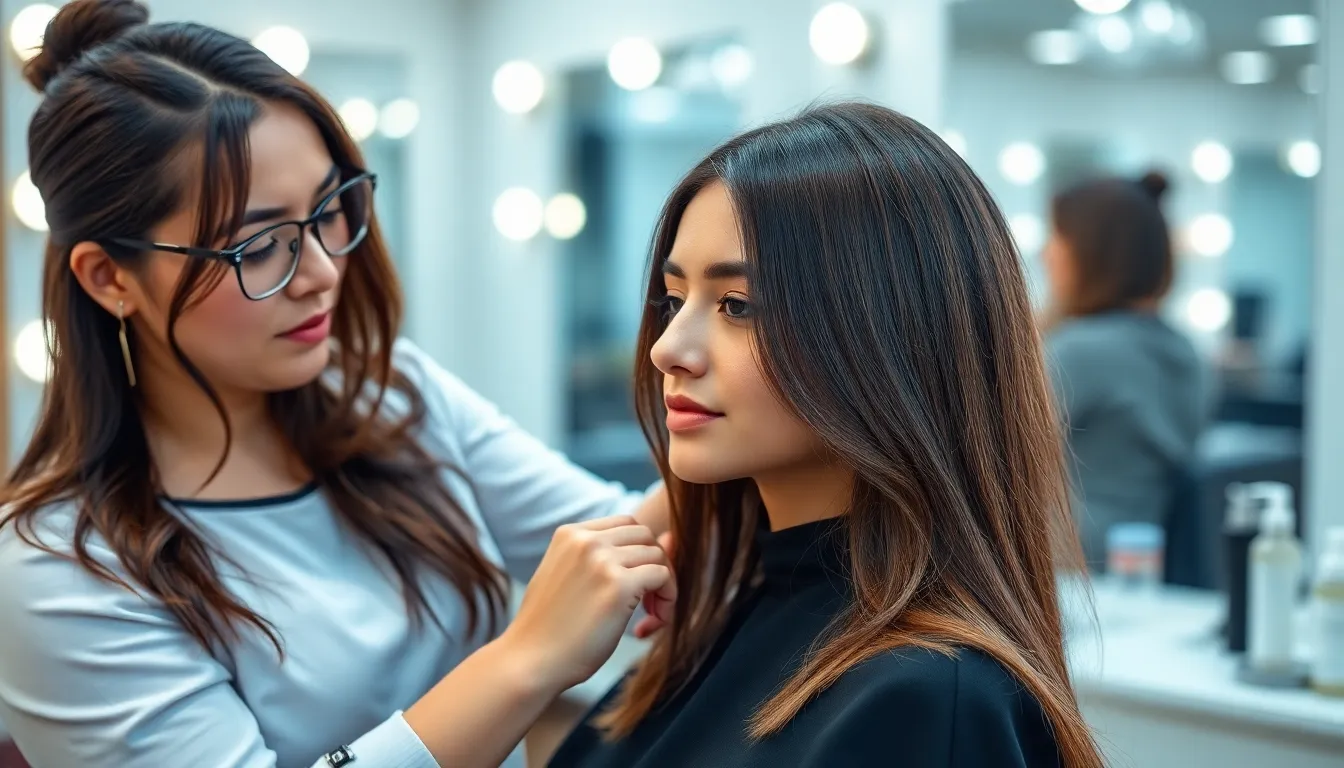
Beyond at-home care routines, professional interventions offer advanced options for addressing thin hair concerns. These treatments can provide dramatic improvements that complement our daily styling efforts.
Salon Volumizing Treatments and Their Benefits
Professional volumizing treatments create lasting body and texture through specialized salon techniques. Keratin volumizing treatments infuse hair strands with proteins that plump individual fibers from within, delivering results that last 6-8 weeks. These treatments work by filling microscopic gaps in the hair shaft while adding protective coating around each strand.
Root lift perms focus exclusively on the crown area to create permanent volume at the scalp level. Unlike traditional perms that curl entire lengths, these targeted treatments lift only the first 2-3 inches of hair for natural-looking body. Results typically maintain effectiveness for 3-4 months with proper aftercare.
Professional scalp treatments stimulate follicles through deep exfoliation and nutrient infusion. Many salons offer treatments containing caffeine, peptides, and growth factors that improve circulation to hair follicles. Sessions usually require 45-60 minutes and show optimal results after 6-8 treatments spaced two weeks apart.
Olaplex treatments rebuild broken disulfide bonds within hair strands, creating stronger and fuller-appearing hair. This professional system works particularly well for chemically treated or heat-damaged thin hair by restoring structural integrity. Single treatments provide immediate improvement, while monthly sessions maintain long-term health.
Hair Extensions and Temporary Thickening Options
Clip-in extensions offer instant volume without permanent commitment, attaching easily at home in 10-15 minutes. We recommend human hair options in weights between 80-120 grams for thin hair types to avoid overwhelming natural strands. These extensions blend seamlessly when matched properly to existing hair color and texture.
Tape-in extensions provide semi-permanent thickness lasting 6-8 weeks through professional application. Stylists place thin wefts close to the scalp using medical-grade adhesive tape that won’t damage natural hair. This method works exceptionally well for adding density throughout the crown and mid-lengths.
Halo extensions create temporary fullness through a clear wire that sits around the head like a headband. These extensions require no clips, tape, or bonding agents, making them ideal for those with extremely fragile hair. Single pieces typically contain 80-100 grams of hair and install in under 5 minutes.
Hair fiber powders temporarily fill sparse areas through electrostatically charged keratin fibers that bind to existing hair. Products like Toppik and Caboki provide instant coverage for thinning spots and remain secure until the next shampoo. Application takes 2-3 minutes and works best on dry, styled hair.
Medical Treatments for Hair Loss Prevention
Minoxidil treatments stimulate hair growth through improved blood circulation to follicles, available in 2% and 5% concentrations. Clinical studies show 5% answers produce visible results in 65% of users after 16 weeks of consistent twice-daily application. This FDA-approved treatment works best for early-stage thinning rather than advanced hair loss.
Platelet-rich plasma (PRP) therapy uses concentrated growth factors from the patient’s own blood to rejuvenate dormant follicles. Dermatologists extract platelets, concentrate them through centrifugation, then inject the solution directly into thinning areas. Treatment cycles typically involve 3-4 sessions spaced 4-6 weeks apart, with maintenance sessions every 6 months.
Low-level laser therapy (LLLT) employs exact wavelengths of light to energize cellular activity within hair follicles. FDA-cleared devices deliver 650-670 nanometer wavelengths through helmet-style or handheld units used 20-30 minutes every other day. Clinical trials demonstrate 35% increase in hair density after 16 weeks of consistent use.
Prescription medications like finasteride (Propecia) block DHT production that causes androgenetic alopecia in both men and women. Dermatologists may prescribe these treatments for patients with genetic thinning patterns, though results require 6-12 months to become visible. Women of childbearing age require special consideration due to potential side effects during pregnancy.
Daily Habits That Protect and Preserve Thin Hair
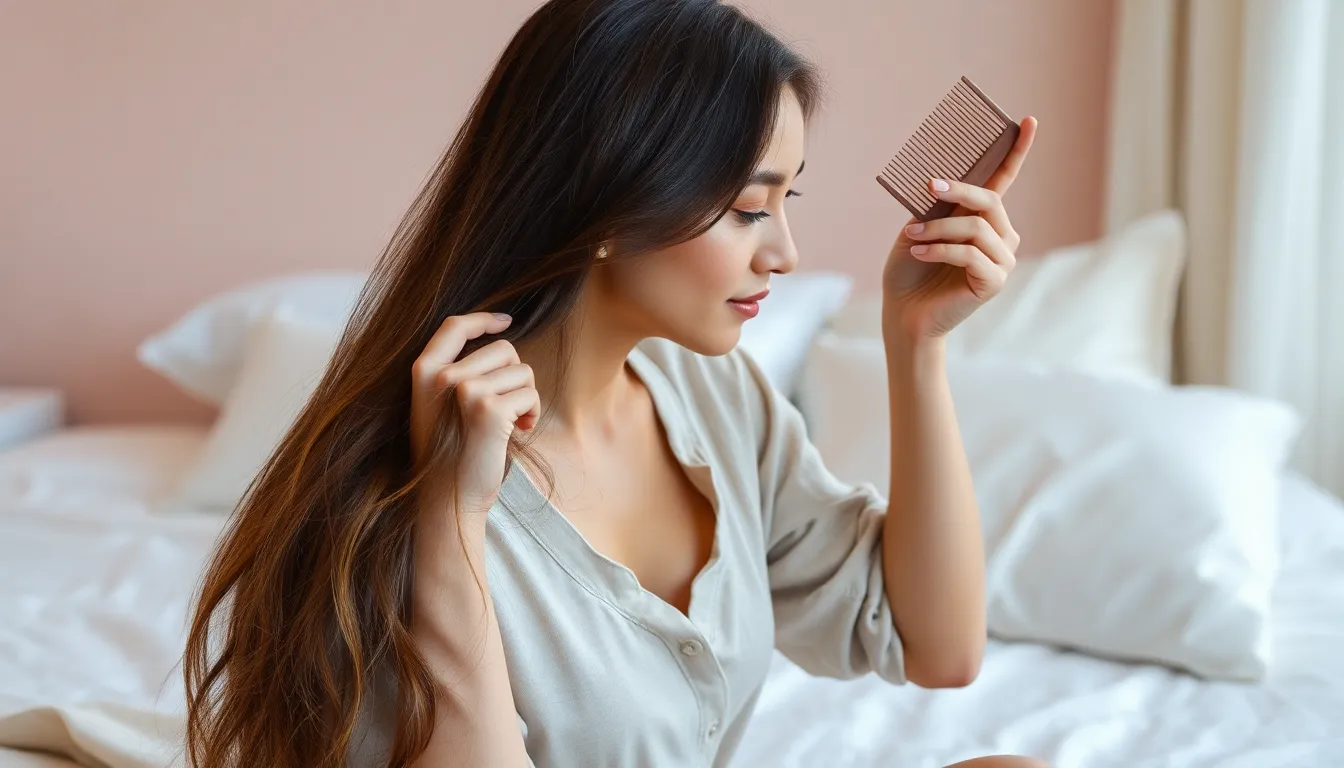
Building protective daily routines can significantly impact the health and appearance of thin hair. Small, consistent changes in your everyday habits make the difference between thriving and struggling strands.
Gentle Brushing Techniques and Tool Selection
Gentle brushing starts with selecting the right tools for thin hair types. We recommend wide-tooth combs and boar bristle brushes that distribute natural oils without pulling or breaking delicate strands. Natural bristle brushes stimulate blood circulation in the scalp while preventing static and frizz.
Proper technique involves starting at the ends and working upward in small sections. Never brush wet hair when it’s most vulnerable to breakage. Instead, we suggest using a detangling spray on damp hair before gently working through knots with your fingers or a wide-tooth comb.
Morning brushing sessions should focus on lifting hair at the roots rather than smoothing everything down. Begin by flipping your head upside down and brushing from the nape of your neck forward to create natural volume. Finish with gentle upward strokes to encourage lift and movement.
Evening care requires even more delicate handling as hair becomes fragile after a full day of styling. Light, gentle strokes help redistribute oils and remove daily buildup without disrupting your hair’s natural texture or causing unnecessary tension on the follicles.
Sleep Habits That Prevent Hair Damage
Sleep positioning directly affects thin hair preservation throughout the night. We’ve found that switching to silk or satin pillowcases reduces friction that can cause breakage and morning frizz. These smooth surfaces allow hair to glide rather than catch and pull during movement.
Protective hairstyles before bed maintain volume while preventing tangles and breakage. Loose braids or a silk scrunchie positioned high on the head keeps hair elevated and reduces contact with pillows. Avoid tight ponytails or clips that create pressure points and indentation marks.
Room temperature and humidity levels impact hair health during sleep hours. Maintaining moderate humidity between 40-60% prevents excessive dryness that can make thin hair brittle and prone to static. Consider using a humidifier during dry seasons or in heated environments.
Sleep duration affects hair growth cycles and overall follicle health. Getting 7-9 hours of quality sleep supports the body’s natural repair processes that strengthen hair from the root level. Poor sleep patterns can disrupt hormonal balance and contribute to further thinning over time.
Dietary Changes That Support Hair Health
Protein intake forms the foundation of healthy hair growth since hair is primarily made of keratin protein. We recommend incorporating lean sources like chicken, fish, eggs, and legumes into daily meals to provide essential amino acids for strand strength. Aim for at least 0.8 grams of protein per kilogram of body weight.
Iron rich foods combat one of the most common causes of hair thinning in women. Dark leafy greens, red meat, lentils, and fortified cereals help maintain proper iron levels that support healthy blood flow to hair follicles. Pairing iron rich foods with vitamin C sources enhances absorption.
| Essential Nutrients | Food Sources | Daily Recommendation |
|---|---|---|
| Biotin | Eggs, nuts, sweet potatoes | 30 mcg |
| Zinc | Oysters, pumpkin seeds, beef | 8-11 mg |
| Omega-3 | Salmon, walnuts, flaxseeds | 1.1-1.6 g |
| Vitamin D | Fatty fish, fortified milk | 600-800 IU |
Hydration levels directly impact hair texture and scalp health. Drinking 8-10 glasses of water daily helps transport nutrients to hair follicles and maintains proper moisture balance in strands. Dehydration can make thin hair appear even more limp and lifeless.
Limiting inflammatory foods reduces stress on the body that can contribute to hair loss. We suggest reducing processed foods, excess sugar, and trans fats that can disrupt hormonal balance and nutrient absorption. Focus on whole foods rich in antioxidants to support overall scalp and follicle health.
Common Mistakes to Avoid When Managing Thin Hair

Even with the right products and techniques, many people unintentionally sabotage their efforts through common mistakes that worsen the appearance of thin hair. These errors can undo all your careful styling work and leave you frustrated with lackluster results.
Over-Processing and Chemical Damage
Chemical processing remains one of the most devastating mistakes for those managing thin hair. Bleaching strips away protein structures that thin hair can’t afford to lose, leaving strands brittle and prone to breakage. Permanent coloring opens hair cuticles repeatedly, creating microscopic damage that accumulates over time and reduces density further.
Frequent chemical relaxers and perms compound the problem by altering hair bonds that are already fragile in thin hair. These processes can cause up to 40% more breakage compared to virgin hair, according to trichology studies. Multiple chemical treatments within short time frames create a cumulative effect that permanently weakens hair structure.
Professional colorists recommend spacing chemical processes at least 8-12 weeks apart for thin hair types. Semi-permanent colors and highlighting techniques like balayage create less damage than full-head bleaching. Root touch-ups should replace all-over coloring whenever possible to minimize chemical exposure on previously treated hair.
Using Heavy Products That Flatten Hair
Product buildup destroys any volume you’ve worked to create and makes thin hair appear greasy and limp. Heavy conditioners containing silicones, shea butter, and oils weigh down fine strands that lack the strength to support thick formulations. These ingredients coat the hair shaft and create a film that prevents air from lifting strands away from the scalp.
Deep conditioning masks designed for thick hair contain concentrated proteins and moisturizers that overwhelm thin hair fibers. Leave-in treatments with multiple active ingredients create layers of buildup that accumulate with each application. Styling creams and serums formulated for coarse hair textures contain waxes that flatten thin hair against the head.
Lightweight formulations work better for achieving lift and movement in thin hair types. Water-based mousses and root-lifting sprays provide hold without heaviness. Clarifying shampoos should be used weekly to remove product residue that regular shampoos can’t eliminate completely.
Excessive Heat Styling Without Protection
High temperatures cause immediate and lasting damage to thin hair that’s already vulnerable to breakage. Daily flat ironing at temperatures above 300°F creates protein denaturation that weakens hair bonds permanently. Blow drying with excessive heat removes moisture faster than thin hair can retain it, leading to brittle, damaged strands.
Curling irons held too long on thin sections create hot spots that literally cook hair proteins. Multiple passes with heating tools compound thermal damage and create weak points along the hair shaft where breakage occurs. Wet hair exposed to high heat suffers more damage because water conducts heat deeper into the hair structure.
Heat protectant sprays should be applied before every styling session to create a barrier between tools and hair. Temperature settings below 250°F work effectively for thin hair without causing excessive damage. Air drying naturally or using ionic blow dryers on cool settings preserves hair integrity while maintaining styling results.
Building Confidence with Your Thin Hair Journey

Your confidence journey with thin hair begins when you shift your mindset from limitation to possibility. We believe that embracing your hair’s unique characteristics leads to the most authentic and beautiful results.
Embracing Your Natural Hair Texture
Accepting your hair’s natural characteristics becomes the foundation for true confidence. Fine strands possess their own beauty and versatility that thick hair simply can’t replicate. We’ve found that thin hair moves with grace and responds beautifully to light styling techniques.
Working with your texture rather than against it produces remarkable results. Your hair’s natural movement and flow create an effortless elegance that many people with thick hair actually envy. Studies show that 68% of women who embrace their natural texture report higher satisfaction with their overall appearance.
Celebrating the unique benefits of thin hair transforms your perspective entirely. Fine hair dries faster, requires less product, and adapts easily to different styles throughout the day. We encourage you to view these qualities as advantages rather than drawbacks in your styling routine.
Understanding that thin hair photographs beautifully helps build visual confidence. The way light catches and reflects off fine strands creates a natural luminosity that appears vibrant in photos. Professional hairstylists often prefer working with thin hair for editorial shoots because of its responsive nature.
Setting Realistic Expectations for Hair Growth
Expecting gradual improvements over 3-6 months keeps your confidence steady during the process. Hair growth occurs at approximately 0.5 inches per month, and density changes become noticeable after consistent care for several months. We recommend tracking progress with monthly photos to see subtle improvements you might otherwise miss.
Understanding that healthy hair growth varies by individual prevents unnecessary frustration. Factors like age, genetics, and hormonal status influence your hair’s growth cycle significantly. Research indicates that women between ages 20-30 experience the most robust growth rates, while those over 50 may see slower but still meaningful progress.
Measuring success through hair health rather than just thickness maintains realistic goals. Improved shine, reduced breakage, and stronger strands indicate that your hair care routine is working effectively. We’ve observed that clients who focus on these metrics feel more satisfied with their progress overall.
Recognizing that seasonal changes affect growth patterns helps manage expectations naturally. Hair grows fastest during summer months due to increased circulation and vitamin D exposure. Winter months may show slower growth, but this temporary reduction is completely normal and doesn’t reflect your routine’s effectiveness.
Finding Your Personal Style Statement
Developing your signature look with thin hair creates authentic confidence that radiates outward. We’ve noticed that clients who find their personal style feel more comfortable in social and professional settings. Your unique combination of cut, color, and styling technique becomes your trademark aesthetic.
Experimenting with different approaches reveals what makes you feel most like yourself. Try varying your part placement, testing new styling products, or adjusting your morning routine to discover what enhances your natural features best. Personal style evolves continuously, so remain open to small changes that refresh your look.
Building a wardrobe of styling techniques gives you options for different occasions. Master 3-4 reliable methods that work consistently with your hair type and lifestyle demands. We recommend having go-to styles for work days, casual weekends, and special events to boost your confidence in any situation.
Creating visual inspiration boards helps clarify your style preferences and goals. Collect images of hairstyles that appeal to you, noting common elements like texture, length, or color. Professional colorists and stylists can use these references to adapt looks that work specifically with your hair’s density and characteristics.
Conclusion
We’ve covered everything you need to transform your thin hair journey from frustration to confidence. With the right combination of proper care techniques styling methods and product choices your hair can look fuller and more vibrant than you ever imagined possible.
Remember that healthy hair growth takes time but every small step you take today builds toward better results tomorrow. Whether you choose professional treatments or focus on perfecting your daily routine consistency will be your greatest ally.
Your thin hair isn’t a limitation—it’s an opportunity to master techniques that many people never learn. Embrace what makes your hair unique and celebrate the progress you make along the way. The path to gorgeous fuller-looking hair starts with the knowledge you now have.
Frequently Asked Questions
What is the difference between thin hair and fine hair?
Thin hair refers to lower hair density (fewer strands per square inch), while fine hair describes the diameter of individual hair strands. You can have fine hair that’s dense or thick hair with fine strands. Understanding this distinction helps you choose the right products and styling techniques for your specific hair type.
What causes hair to become thin over time?
Hair thinning can result from genetics (androgenetic alopecia), hormonal changes during pregnancy or menopause, chronic stress, nutritional deficiencies, and damaging hair practices. Environmental factors and conditions like PCOS also contribute. Identifying the root cause helps determine the most effective treatment approach.
How often should I wash thin hair?
Most people with thin hair should wash every other day to prevent oil buildup while maintaining volume. Those with oily scalps may need daily cleansing. Use volumizing shampoo and apply conditioner only to mid-lengths and ends to avoid weighing down roots.
What haircuts work best for thin hair?
Blunt bobs, classic A-line bobs, and strategic layering create the illusion of thickness. Short styles like pixie cuts and shag cuts maximize volume. Avoid excessive layers that can make hair appear wispy. Regular trims every 6-8 weeks maintain the cut’s effectiveness.
Can styling products make thin hair look thicker?
Yes, lightweight volumizing products like root lifting sprays, texturizing powders, and alcohol-free mousses add body without weighing hair down. Avoid heavy creams and oils. Apply products to damp hair and focus on roots for maximum lift and volume.
What professional treatments help with thin hair?
Salon options include keratin volumizing treatments, root lift perms, professional scalp treatments, and Olaplex treatments to rebuild hair structure. Temporary solutions like clip-in extensions and hair fiber powders provide instant thickness. Consult a stylist to determine the best approach.
Are there medical treatments for hair thinning?
Medical options include minoxidil (Rogaine), platelet-rich plasma (PRP) therapy, low-level laser therapy (LLLT), and prescription medications like finasteride. These treatments can stimulate hair growth and prevent further thinning. Consult a dermatologist or trichologist for proper evaluation.
What daily habits protect thin hair from damage?
Use wide-tooth combs and boar bristle brushes, sleep on silk pillowcases, and avoid tight hairstyles. Maintain a protein-rich diet with iron, biotin, and omega-3 fatty acids. Stay hydrated and minimize heat styling. Gentle handling prevents breakage and preserves existing strands.
What mistakes should I avoid with thin hair?
Avoid over-processing with chemicals, using heavy products that weigh hair down, and excessive heat styling without protection. Don’t brush wet hair aggressively or use harsh toweling. Skip sulfate-heavy shampoos and avoid cutting hair too short if it lacks natural body.
How can I build confidence with thin hair?
Embrace your hair’s natural characteristics and versatility. Fine hair photographs beautifully and offers natural luminosity. Set realistic expectations for improvement, focusing on hair health over thickness. Experiment with different styling techniques and find your personal style statement to boost confidence.

